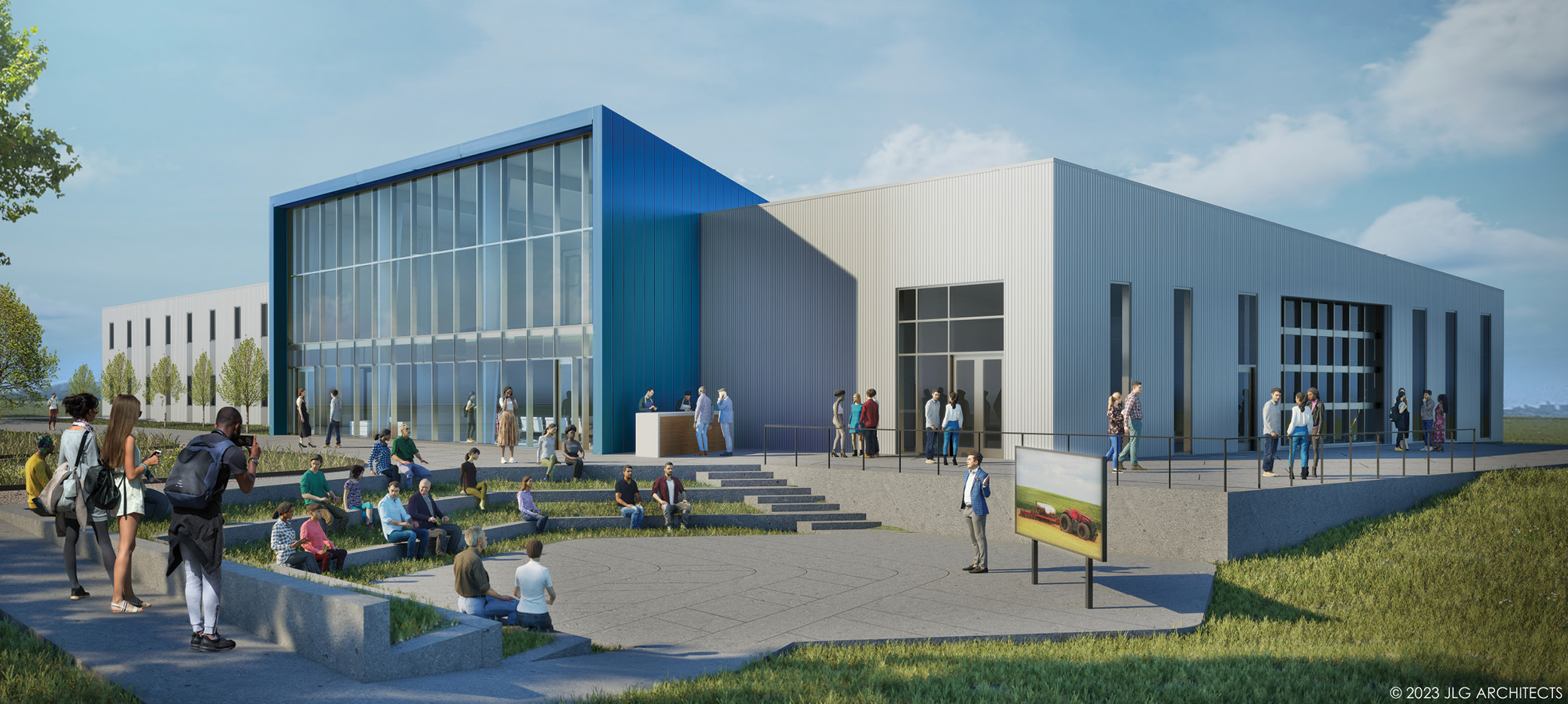Over the next few years, with the help of innovative practices, the processes behind farming and food production will take a new direction that optimizes resources and safety while producing high-quality, healthy crops.
An example is blooming near the eastern North Dakota city of Casselton. By the end of 2025, the 140-acre Grand Farm Innovation Campus will introduce farmers, food producers and researchers to emerging technology that seeks to mitigate challenges within the state’s agricultural industry.
Grand Farm is being built out in phases with the first building expected to be completed in May 2024. The initial building will house the Innovation Shop, which features shop space for partners to work on equipment and products, collaboration space with board rooms and offices, and event space leading to an outdoor amphitheater.
In September 2023, North Dakota Governor Tammy Miller announced that Georgia-based agricultural machinery and technology company AGCO is constructing a 300-acre “Smart Farm” on the Grand Farm site where AGCO-owned Appareo Systems’ team of agronomists, scientists, engineers and agricultural experts will lead agronomy studies and on-site tours to inform local farmers about sustainable and precision farming practices.
“Within the last several years, we’ve seen a lot of automation on board some of the farming equipment. I think that’s only going to progress, and Grand Farm is going to be doing a lot of research on that,” says North Dakota Department of Commerce Economic Development & Finance Director Rich Garman. “One of the keys I see is autonomy and automation of processes on the farm. Farmers can then eliminate some of the need for the manual labor.”
No, this is not a case of robots replacing the need for human skills. These technologies and automation look to pinpoint tedious practices and provide data that can save time and money. The technology essentially allows farmers to take out the guesswork and replace it with real-time data. From soil health to precipitation measurements throughout a field, farmers and producers can monitor the health of their crops without the need for manual labor.
North Dakota Department of Commerce Agriculture and BioEnergy Development Manager Kevin Sonsalla says agricultural challenges include unpredictable weather, droughts, pests, food waste, storage issues and workforce shortages. By having this new asset on hand, industry professionals have access to groundbreaking technology to make incisive judgements that lead to a prosperous harvest.
“Things like targeted weed mitigation versus spraying an entire field,” says Sonsalla. “Improving crop yields through monitoring crop conditions in real time, which allows producers to make better, more informed decisions. There’s labor cost savings that come along with what they’re planning to do at Grand Farm in addition to improving safety by utilizing automation equipment for more dangerous activities that take place in production agriculture.”
“An expansion of that size will have positive economic ripples throughout our region.”
— Tim Reed, CEO, Brookings Economic Development Corp., on 3M’s $468 million expansion
After a phase one fundraising round the Innovation Campus secured more than $15 million. This funding is supported by the North Dakota Department of Commerce’s $10 million one-to-one matching grant. DOC funding will be used to support the Grand Farm Education and Research Initiative upon buildout.
The project reflects the state’s drive for innovation over regulation, says Garman.
“I don’t believe that a facility like Grand Farm will ever be completely done,” says Garman. “As technology improves and changes over time, they’re going to be continually changing what they’re studying and what they’re innovating. It’s going to be a constant work in progress that they will continue on indefinitely.”
Room For Growth
When 3M Company moved into Brookings, South Dakota, in 1969, its investment represented one of the first manufacturing plants to be recruited to the city.
At the time, the site was the leading industrial manufacturer’s first and largest health care facility. Over 50 years later, this site works around the clock to produce of a variety of vital medical, surgical and food safety products for medical facilities, manufacturing sites and homes around the nation.
“3M has brought and continues to bring high-paying jobs with excellent benefits to Brookings,” says Brookings Economic Development Corporation CEO Tim Reed. “Part of Brookings’ growth strategy is recruiting and supporting manufacturing operations with high-paying jobs. That focus has led to the current statistic that 20% of our workforce is employed in manufacturing.”
In July 2023, the company announced it would be investing up to $468 million over the next three years to expand the 54-year-old site. Reed says 3M has already broken ground on its first phase of expansion. To start, the company will use $158 million to grow the 667,000-sq.-ft. facility with an additional 200,000 sq. ft. of manufacturing space, an 8,000-slot warehouse and 16 new shipping docks.
More than $300 million is expected go toward the facility by 2026. Overall, the Brookings project will create approximately 50 new jobs.
“The Brookings Economic Development Corporation in partnership with the South Dakota Governor’s Office of Economic Development has been working with 3M for more than a year to secure their expansion in Brookings,” says Reed. “Hearing that the final amount was $468 million was very exciting. An expansion of that size will have positive economic ripples throughout our region.”
Advanced manufacturing has been a strategic focus for Brookings EDC. Providing resources for growth has aided expansions such as 3M’s. For the state as a whole, manufacturing accounts for one out of 10 jobs, while 93% of the state’s exports are manufactured goods.
In terms of talent, the industry is strongly supported by local institutions.
“One of our greatest assets in Brookings is South Dakota State University,” says Reed. “The University has a strong college of engineering, advanced manufacturing plants need engineers and having options in Brookings will attract those graduates to live in Brookings and keep our community growing.”

